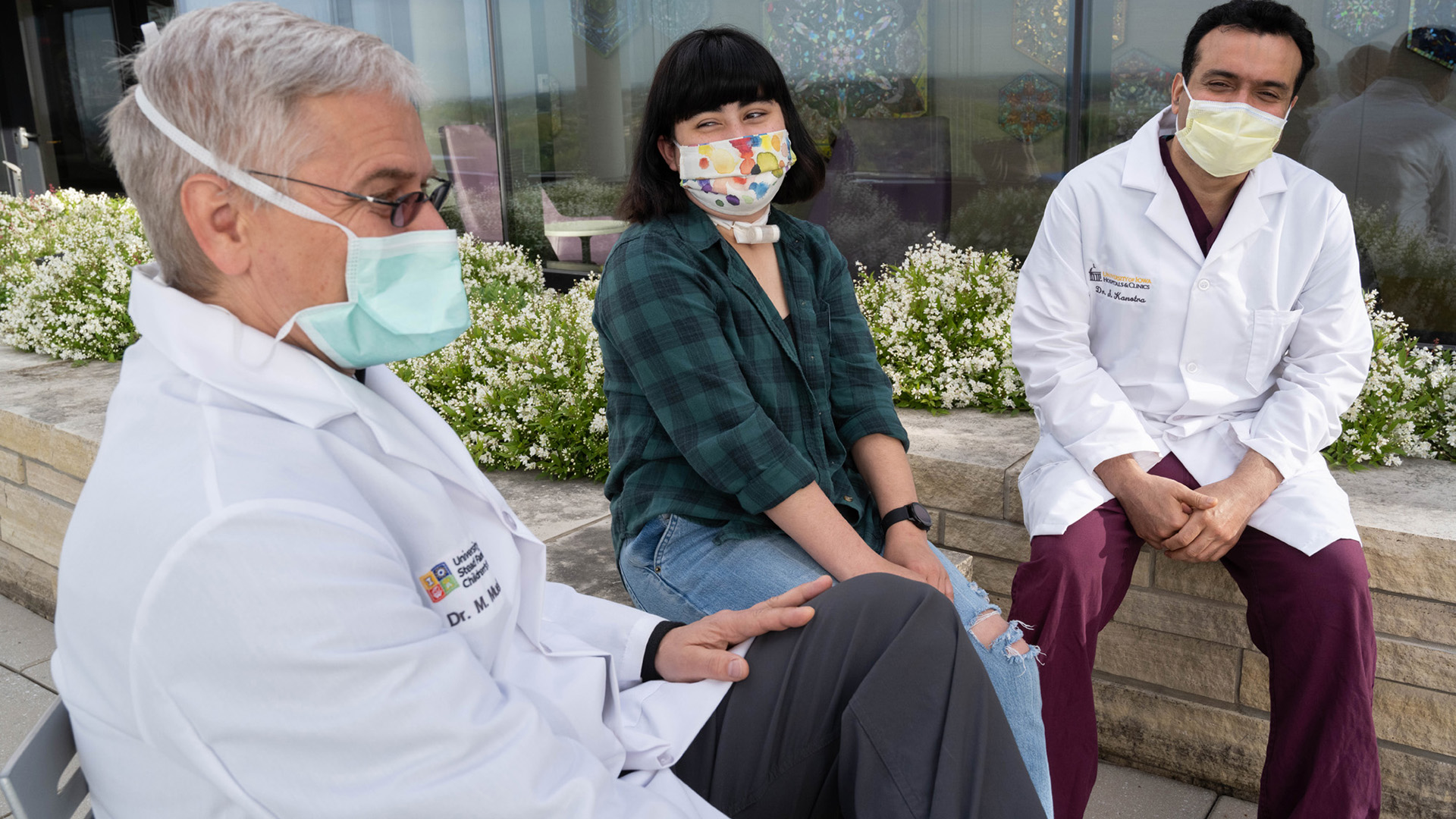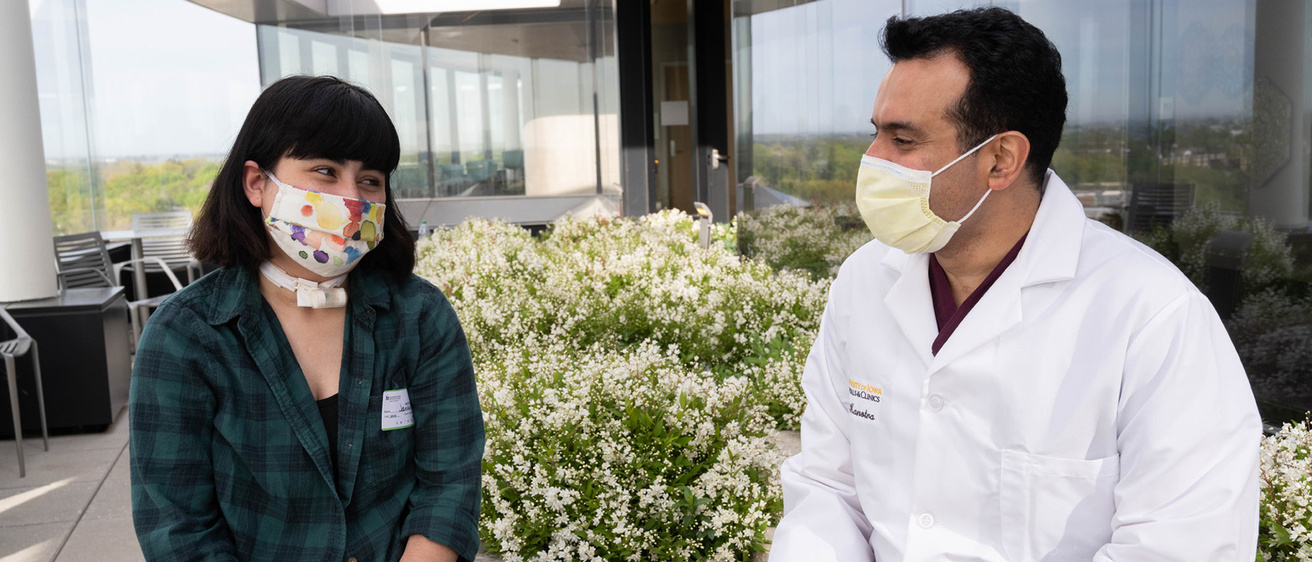After enduring close to 100 procedures to keep her airway open, a central Iowa teen is seeing potential for normalcy following a complex throat surgery at the University of Iowa in 2019.
Story: Sara Epstein Moninger
Photography: Tim Schoon
Published: June 14, 2021
The top photo...
While receiving care at UI Health Care Stead Family Children’s Hospital, Iowa teen Nina Alvarez has grown close to members of her pediatric health care team, including otolaryngologist Sohit Kanotra.
In the predawn hours of Nov. 4, 2019, 17-year-old Nina Alvarez climbed out of bed, said goodbye to her dogs, and drove away from her family home in Winterset, Iowa. Sleepy yet nervous and excited, she had been waiting for this moment her whole life.
Alvarez had never known what “breathe easy” meant because prolonged ventilator use as a preemie and subsequent years of multiple airway dilations had left her throat scarred. But a pediatric otolaryngologist at University of Iowa Health Care Stead Family Children’s Hospital was promising to change that.
When Alvarez first met Sohit Kanotra, MD, who had been hired just months earlier to lead Iowa’s pediatric aerodigestive clinic, she felt a resurgence of hope. He had proposed a cricotracheal resection, a surgery to remove a narrowed segment of her windpipe. It was a challenging procedure but one Kanotra had done many times before and usually took him about four hours to complete. This one lasted close to 10 hours.
“It was Nina’s fourth big surgery to open the airway, and her airway had been scarred so much due to previous surgeries that it was hard to distinguish the windpipe from the surrounding structures,” Kanotra says. “I knew it was going to be tough, but I was not expecting it to be as bad as it was.”
It was a high-risk surgery — and a successful one. Within months, Alvarez turned 18 and graduated from high school. She now works full-time at Fareway Grocery as she assesses her career interests before starting college. She enjoys creating art on her iPad and working with kids. Perhaps, she says, she will become a teacher.
Although Alvarez’s voice will likely always sound hoarse, Kanotra says he is pleased by what he has seen in her airway during follow-up appointments and is optimistic about her future.
“This place feels like our second home. The members of Nina’s health care team are like good friends and family at the same time. They sit down with us and take the time to find out what she’s doing and what she likes. They make connections.”
Learning to ‘cherish every day’
Alvarez, like most pediatric patients facing complex airway surgery, had a rough start in life. She was born three months early in a Des Moines hospital on Dec. 26, 2001. Because her lungs were underdeveloped, she needed ventilator support, which caused airway trauma and required a tracheostomy—a medical procedure that creates an opening in the neck to insert a breathing tube or “trach”—in order for her to breathe.
It was a particularly stressful time for her mother, Laresa Carney, who had many sleepless nights staying up with her young daughter in case the trach came out.
“It was overwhelming,” says Carney, who has two older children. “If the trach popped out, Nina could have died. There were times I had to resuscitate her.”
In 2004, Carney brought Alvarez to Stead Family Children’s Hospital for surgery to open her airway using a cartilage graft and to remove the trach. Because of developing scar tissue, the pair had to repeatedly make the two-and-a-half-hour drive to Iowa City to have Alvarez’s airway dilated, as frequently as every two months. When the new Stead Family Children’s Hospital building opened in 2017, Alvarez was among its first patients.
“This place feels like our second home,” says Carney, who was inspired to become a nurse after caring for her daughter. “The members of Nina’s health care team are like good friends and family at the same time. They sit down with us and take the time to find out what she’s doing and what she likes. They make connections.”
As good as the care is, however, frequent hospital stays are not what any parent wants for their child. Carney says she’s not sure how many airway procedures Alvarez has had — she lost track around 50 — but estimates it to be near 100. She tries to remain positive and is grateful for every day her daughter can breathe.
“When Nina was first born, it was a roller coaster ride. You’d have days when things would be OK and ones when they weren’t OK. It’s been hard, but you do it because you have no other choice,” Carney says. “Some people have just one surgery and it’s devastating for them. But that has become our normal. You have to do the best with what you have and cherish every day.”
“It’s not just what I do as a surgeon that is important. We have a full team of excellent providers at UI Stead Family Children’s Hospital — including our anesthesiologists, intensive care unit nurses, and speech therapists — and that makes a world of difference in the care of our patients.”
A ‘new hope’ arrives
As Alvarez progressed through school and approached adulthood, Carney began researching more permanent options for her daughter. She scouted hospitals that specialized in pediatric airway reconstructions, places like Mayo Clinic and Massachusetts General Hospital. Surely there must be a better future than going to a hospital every few months to be able to breathe.
Then she got a welcome call from Stead Family Children’s Hospital.
“They said they had hired a doctor who specialized in airway surgery,” Carney says. “Nina has always held out hope that someday she’d be able to breathe on her own, without having to come in all the time, and meeting Dr. Kanotra gave her new hope that that will happen.”
Kanotra, the son of an ear, nose, and throat (ENT) doctor in India, had spent five years building the airway program at Louisiana State University in New Orleans before joining Iowa’s staff. Although he had performed dozens of airway resection surgeries, he says Alvarez’s was the toughest he had ever done.
“The magnitude of the surgery was immense,” he says. “But it’s not just what I do as a surgeon that is important. We have a full team of excellent providers at UI Stead Family Children’s Hospital — including our anesthesiologists, intensive care unit nurses, and speech therapists — and that makes a world of difference in the care of our patients.”

Nina Alvarez visits with anesthesiologist Martin Mueller (left) and otolaryngologist Sohit Kanotra in the Healing Garden on the top floor of University of Iowa Stead Family Children's Hospital during a visit in May 2021.
Making Iowa a destination for airway expertise
Kanotra says his goal is to give hope to patients like Alvarez and their families, many of whom have been told they’d have to breathe through a tube for the rest of their lives. UI Stead Family Children’s Hospital performs 15 to 20 open-airway procedures each year, with the rarer resections numbering two or three a year.
“The fact is we offer every airway surgery on the planet, so Iowans don’t have to go outside the state,” Kanotra says. “We specifically target kids who have airway issues and have a tracheostomy, and we work with our colleagues from pediatric pulmonology and pediatric gastroenterology to coordinate services, so that patients don’t have to make multiple trips. Just imagine having your child’s life dependent on a plastic tube in her neck. If that tube gets blocked or comes out, the child won’t be able to breathe. It’s very stressful.”
Laresa Carney says she’s grateful for Kanotra and having his expertise so close to home. She believes his experience working on Alvarez’s throat will help other ENT patients.
A holistic, individualized approach
A young patient deserves to be treated as a whole person, not just a set of symptoms or problems. The Aerodigestive and Tracheostomy Clinic at University of Iowa Stead Family Children’s Hospital provides comprehensive evaluation and management of complex airway and swallowing disorders. Care is coordinated so that families don’t have to make multiple trips.
“It’s inspirational to see what Dr. Kanotra is doing and hear the ideas he has,” Carney says. “Sometimes he’ll call me at home and say, ‘I just went over a case and I slept on it, and I think we should do it.’ I hope Nina’s airway, and those of others, will contribute to further advances in treatment.”
Alvarez can speak, albeit a bit gravelly — something Kanotra says UI speech therapists will continue to work on with her. She has detailed her journey through a Facebook blog called “Nina’s Quest to Just Breathe.”
“My whole life I had been waiting for this moment,” she writes about the surgery. “The risks were high, but the outcome was so much better than the life I was living before.”
